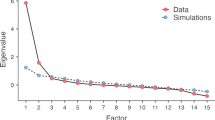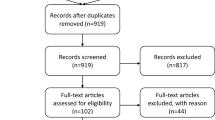Abstract
We surveyed 1,293 employees working in the Ministry of National Education using a sociodemographic questionnaire, the Minnesota Satisfaction Questionnaire, and the Satisfaction with Life Scale. Of these, 680 participants were school counselors (52.59 %), 371 were office staff (28.69 %), and 242 were administrators (18.72 %). Data were analyzed using latent class analysis. A four-class solution was fitted to the current data. Results revealed that 58.93 % of the respondents were satisfied and very satisfied with their current job and life. Among the school counselors, 66.47 % fell into the satisfied and very satisfied latent classes. School counselors reported greater levels of job and life satisfaction compared to other groups of employees. Working in a school and in non-urban settings were significant predictors of job and life satisfaction. Participants with higher levels of education reported higher scores on job and life satisfaction.


Similar content being viewed by others
References
Achor, S. (2010). The happiness advantage: The seven principles of positive psychology that fuel success and performance at work. New York: Crown Business.
Aysan, F., and Bozkurt, N. (2004). Life satisfaction, coping with stress, and negative automatic thoughts of the school psychological counselors: The case of İzmir. Paper presented at the XIII. National Educational Sciences Congress, Malatya.
Baggerly, J. N., & Osborn, D. (2009). School counselors’ career satisfaction and commitment: Correlates and predictors. Professional School Counseling, 9, 197–205.
Brott, P. E., & Myers, J. E. (1999). Development of professional school counselor identity: A grounded theory. Professional School Counseling, 2, 339–348.
Brown, R. E. (1997). African American school psychologists: Job satisfaction and graduate school recruitment and retention. Doctoral Thesis, James Madison University.
Bryant, R. M., & Constantine, M. G. (2006). Multiple role balance, job satisfaction, and life satisfaction in women school counselors. Professional School Counseling, 9, 265–271.
Bulut, N. (2007). Relations between school psychological counselors’ life satisfaction, strategies of coping with stress and negative automatic thoughts. Turkish Psychological Counseling and Guidance Journal, 3(27), 1–13.
Burnham, J. J., & Jackson, C. M. (2000). School counselor roles: Discrepancies between actual practice and existing models. Professional School Counseling, 4, 41–49.
Cervoni, A., & Delucia-Waack, J. L. (2011). Role conflict and ambiguity as predictors of job satisfaction in high school counselors. Journal of School Counseling, 9(1), 1–30.
Clogg, C. C. (1995). Latent class models. In G. Arminger, C. C. Clogg, & M. E. Sobel (Eds.), Handbook of statistical modeling for the social and behavioral sciences (pp. 311–359). New York: Plenium.
Culbreth, J. R., Scarborough, J. L., Banks-Johnson, A., & Solomon, S. (2005). Role stress among practicing school counselors. Counselor Education and Supervision, 45, 58–71.
DeMato, D. S., & Curcio, C. C. (2004). Job satisfaction of elementary school counselors: A new look. Professional School Counseling, 7(4), 236–245.
Diener, E., Emmons, R. A., Larsen, R. J., & Griffin, S. (1985). The satisfaction with life scale. Journal of Personality Assessment, 49(1), 71–75.
Dixon-Rayle, A. L. (2006). Do school counselors matter? Mattering as a moderator between job stress and job satisfaction. Professional School Counseling, 9, 206–215.
Ducharme, L. J., & Martin, J. K. (2000). Unrewarding work, coworker support, and job satisfaction. Work and Occupation, 27, 223–243.
Dutton, J. E., Dukench, J. M., & Harquail, C. V. (1994). Organizational images and member identification. Administrative Science Quarterly, 39, 239–263.
Dutton, J. E., Roberts, L. M., & Bednar, J. (2010). Pathways for positive identity construction at work: Four types of positive identity and the building of social resources. Academy of Management Review, 35(2), 265–293.
Dutton, J. E., Roberts, L. M., & Bednar, J. (2011). Prosocial practices, positive identity, and flourishing at work. In S. Donaldson, M. Csikszentmihalyi, & J. Nakamura (Eds.), Applied positive psychology: improving everyday life, schools, work, health, and society (pp. 155–170). New York: Routledge.
Hackman, J. R., & Oldman, G. R. (1976). Motivation through the design of work: Test of theory. Organizational Behavior and Human Performance, 16, 250–279.
Hagenaars, J. A., & Halman, L. C. (1989). Searching for ideal types: The potentialities of latent class analysis. European Sociological Review, 5, 81–96.
Hamamcı, Z., Oskargil-Göktepe, E., & İnanç, N. (2004). The investigation of the relationship between career development and job satisfaction among psychological counselors working in schools. Paper presented at the XIII. Malatya: National Congress of Educational Sciences.
Hirschfield, R. R. (2000). Does revising the intrinsic and extrinsic subscales of the Minnesota Satisfaction Questionnaire Short Form make a difference? Educational and Psychological Measurement, 60(2), 255–270.
Jewell, L. N. (1998). Contemporary industrial/organizational psychology (3rd ed.). Pacific Grove, CA: Brooks, Cole.
Jones, C., Hohenshil, T. H., & Burge, P. (2009). Factors affecting African American counselors’ job satisfaction: A national survey. Journal of Counseling & Development, 87, 152–158.
Judge, T. A., & Klinger, R. (2008). Job satisfaction: Subjective well-being at work. In M. Eid & R. Larsen (Eds.), The science of subjective well-being (pp. 393–413). New York: Guilford Publications.
Kayri, M., & Okut, H. (2008). Scrutinization of risk analysis related to success of the private skill exam by using mixture logistic regression model. Hacettepe University Journal of Education, 35, 227–239.
Köker, S. (1991). Comparison of the levels of life satisfaction between normal and problematic adolescents Master Thesis, Ankara University, Ankara.
Kolodinsky, P., Draves, P., Schroder, V., Lindsey, C., & Zlatev, M. (2009). Reported levels of satisfaction and frustration by Arizona school counselors: A desire for greater connections with students in a data-driven era. Professional School Counseling, 12, 193–199.
Landy, F. J. (1978). An opponent process theory of job satisfaction. Journal of Applied Psychology in the Schools, 63, 533–547.
Lanza, S. T., Collins, L. M., Lemmon, D. R., & Schafer, J. L. (2007). PROC LCA: A SAS procedure for latent class analysis. Structural Equation Modeling, 14(4), 671–694.
Lawler, E. E. (1973). Motivation in work organizations. Pacific Groves, CA: Brooks and Cole.
Leiter, M. P., & Meechan, K. A. (1986). Role structure and burnout in the field of human services. The Journal of Applied Behaviour Sciences, 22, 47–52.
Locke, E. A. (1976). The nature and causes of job satisfaction. In M. D. Dunnette (Ed.), Handbook of industrial and organizational psychology (pp. 1297–1349). Chicago: Rand McNally.
Martin, U., & Schinke, S. P. (1998). Organizational and individual factors influencing job satisfaction and burnout of mental health workers. Social Work in Health Care, 28, 51–62.
Muchinsky, P. M. (2000). Psychology applied to work: An introduction to industrial and organizational psychology (6th ed.). Belmont, CA: Wadsworth.
Ok, S. (2004). Investigation of the job burnout among bank employees due to job satisfaction, role conflict, role ambiguity and several personal characteristics. Turkish Psychological Counseling and Guidance Journal, 3(21), 57–67.
Olson, M. J., & Dilley, J. S. (1998). A new look at stress and the school counselor. The School Counselor, 35, 194–198.
Paisley, P. O., & McMahon, G. (2001). School counselors in the 21st century: Challenges and opportunities. Professional School Counseling, 5, 106–115.
Piersonhubeny, D., & Archambault, F. X. (1987). Role stress and perceived intensity of burnout among school-psychologists. Psychology in the Schools, 24(3), 244–253.
Pugliesi, K. (1999). The consequences of emotional labor: Effects on work stress, job satisfaction, and well-being. Motivation and Emotion, 23, 125–154.
Scarborough, J. L., & Culbreth, J. R. (2008). Examining discrepancies between actual and preferred practice of school counselors. Journal of Counseling and Development, 86(4), 446–459.
Schaffer, R. H. (1953). Job satisfaction as related to need satisfaction in work. Psychological Monographs: General and Applied, 67(14), 1–29.
Sears, S. J., & Granello, D. H. (2002). School counseling now and in the future: A reaction. Professional School Counseling, 5, 164–171.
Smith, P. C., Kendall, L. M., & Hulin, C. L. (1969). The measurement of satisfaction in work and retirement. Chicago: Rand McNally.
Smucker, M. K., & Kent, A. (2004). The influence of referent selection on pay, promotion, supervision, work, and co-worker satisfaction across three distinct sport industry segments. International Sports Journal, 8(1), 27–43.
Spector, P. E. (1997). Job satisfaction. Thousands Oaks, CA: Sage.
Spector, P. E. (2000). Industrial and organizational psychology (2nd ed.). New York: Wiley.
Staw, B. M., Bell, N. E., & Clausen, J. A. (1986). The dispositional approach to job attitudes: A lifetime longitudinal test. Administrative Science Journal, 31, 437–453.
Staw, B. M., & Ross, J. (1985). Stability in the midst of change: A dispositional approach to job attitudes. Journal of Applied Psychology, 70, 469–480.
Sürücü, M., & Bacanlı, F. (2007). Investigation of job and life satisfaction among school counselors. Paper presented at the IX. National Congress of Guidance and Psychological Counseling, Malatya.
Uyguç, N., Arbak, Y., Duygulu, E., & Çıraklar, N. (1998). Investigation of job and life satisfaction under three basic assumptions. Dokuz Eylul University Faculty of Economics and Administrative Sciences Journal, 13(2), 193–204.
Vroom, V. H. (1964). Work and motivation. New York: Wiley.
Weiss, D. J., Dawis, R. I., England, G. W., & Lofguist, L. H. (1967). Manual for the Minnesota Satisfaction Questionnaire (Vol. XXII). Minneapolis: University of Minnesota Press.
Wilkerson, K. (2009). An examination of burnout among school counselors guided by stress–strain-coping theory. Journal of Counseling and Development, 87(4), 428–437.
Wilkerson, K., & Bellini, J. (2006). Intrapersonal and organizational factors associated with burnout among school counselors. Journal of Counseling and Development, 84(4), 440–450.
Wofford, J. C. (1971). The motivational basis of job satisfaction and job performance. Personnel Psychology, 24, 501–518.
Wolpin, J., Burk, R. J., & Greenglass, E. R. (1991). Is job satisfaction an antecedent or a consequence of psychological burnout? Human Relations, 44, 193–209.
Yeşilyaprak, B. (2001). Prediction of job satisfaction of school counselors. Eurasian Journal of Educational Research, 1(3–4), 139–143.
Author information
Authors and Affiliations
Corresponding author
Rights and permissions
About this article
Cite this article
Yeşilyaprak, B., Boysan, M. Latent Class Analysis of Job and Life Satisfaction Among School Counselors: A National Survey. J Happiness Stud 16, 1–15 (2015). https://doi.org/10.1007/s10902-013-9491-2
Published:
Issue Date:
DOI: https://doi.org/10.1007/s10902-013-9491-2




